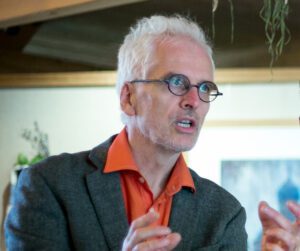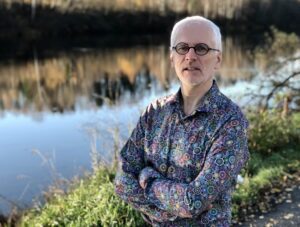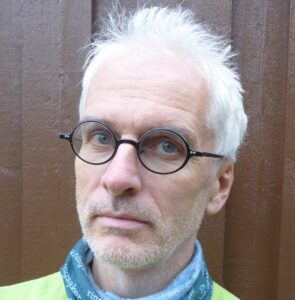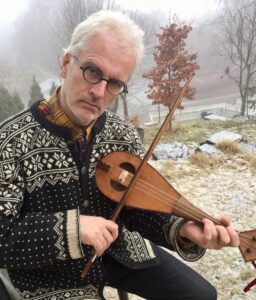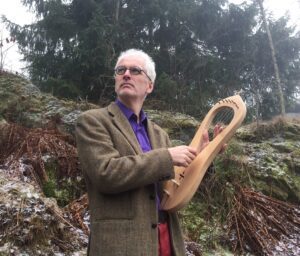Gjermund Kolltveit
Music archaeologist, ethnomusicologist, musician – Nesodden, Norway
MUSARK is a short form of music archaeology (Norw. musikkarkeologi), which is my main professional speciality – a cross-disciplinary field about music and sound in the distant past.
Still, my research covers many interests and wider anthropological perspectives on music.
Researcher
I was trained as a musician and ethnomusicologist before turning to the archaeology of music. My doctorate was about Jew’s Harps in European Archaeology.
As a music archaeologist I have written about instruments and sound tools, such as jew’s harps, lyres, bronze lurs, bullroarers and ringing stones. Furthermore, I have reseached village and animal bells from a perspective of soundscapes, the music of the Norwegian Gypsies, and football supporter chanting.
For several years I have been part of the international music archaeological community, and I have participated actively in conferences and meetings, for instance in the International Study Group on Music Archaeology (ISGMA).
Earlier in my career I was employed in various part-time positions (University of Oslo, University of South-Eastern Norway and Inland Norway University of Applied Sciences). I have developed and taught a number of university courses and given guest lectures in the fields of ethnomusicology and traditional arts. I have also supervised students (BA, MA and PhD).
I am now an independent researcher, but I am involved in some institutional projects, such as registration of ringing stones with Magma Geopark, and the Kone foundation-funded project Sacred Sounds and Ritual Soundscapes hosted by the University of Helsinki.
Musician
Originally I was trained as a classical violinist, and for some years made a living as a free-lance musician, playing in a variety of settings, including The Norwegian National Opera Orchestra. Later, I changed the direction of my musical career, and started to play with different groups and artists in the folk and ‘roots’ genre, including Trond Granlund, Somebody’s Darling, Cajun Mock Frogs, Atle Lien Jenssen, and Tony Sheehan.
Today I play a range of musical instruments, including the violin, hardanger fiddle, viola, melodeons, jew’s harps, flutes, mandolin, board zither and lyres.
During the years I have participated on several albums, with artists and bands as Guren Hagen, Lomsk, Vømlingan, Elias Akselsen, Gazpacho, Tirill Mohn and Finn Coren.
I play in the band Ford Folk, and in 2013 we released our CD Folkemusikk fra Nesodden (’Folk Music from Nesodden’). Here we search for folk music from a semi-rural peninsula of Eastern Norway, with close proximity to Oslo. In 2019 Ford Folk and Ann-Turi Ford released the CD-box Samuels sanger (Grappa), with forty songs after the song source Samuel Hellen (1813–1892). My contribution was as a musician and arranger on many of the tracks.
In 2019 I had the pleasure of doing comeback with the artist Trond Granlund – after a pause of around 20 years. Vi play different kinds of concerts, sometimes with trio, other times with quartet or more musicians. I play the fiddle, mandolin and accordion. Our newest album is Sanger jeg lærte av Jokke (2022).
Nonfiction writer
Besides being a researcher, I am a nonfiction writer. I am a member of Norwegian Non-Fiction Writers and Translators Organization (NFFO). In addition to reviews and popular scientific articles I have written three books in Norwegian.
The first is about a famous folk music album from Setesdal (Skjoldmøyslaget. Faremoslåttar frå Setesdal, 2012), the second is about ancient music, music archaeology and musical instruments (Jordas skjulte toner. Musikk og instrumenter fra steinalder til vikingtid, 2014).
The topic of my newest book is “singing as weaponry” (Sang som våpen. Historier om sangens slagkraft, 2021). This is a broad introduction to the collective and political power of singing
Sound recordist
The roots of this activity come from my life-long interest in birds and nature. As a teenager I started to record birdsong. During my adult days, I have been increasingly inspired by soundscape studies, which was originally intruduced in the 1970s by the Canadian composer Murray Shafer. Sound, silence, and sound environments are increasingly getting attention today, as humans progressively produce more noise.
One way of working with and attend to soundscapes, is to record them. For about a decade I have collected sounds at my home place Fjellstrand. This project, which I call “Soundscape Fjellstrand”, is a documentary work. In principle I include all kinds of sounds that can be heard with the human ears. To exemplify, besides talking, singing, cars and animals, I record underwater sounds of the Oslo Fjord (waves, boats, fish).
My work might be regarded as ‘sound art’, though I am not a big fan of the concept of art. I am more concerned with documentation, although the dimension of experience (aesthetics) with sound is obvious and indeed essential.
Instrument maker
In respect of professional and committed builders of musical instruments, I hesitate to call myself an instrument maker. However, I do build instruments, chiefly reconstructed lyres, bone flutes and other medieval or ancient instruments and sound tools. These artisan activites are connected to my research. One part of my work with Scandinavian lyres is to reconstruct or – rather – make ‘type models’ of a group of medieval lyres found on carved surfaces (portals and smaller woodens objects) in Southern Norway.


